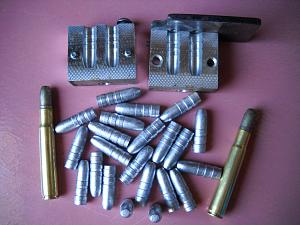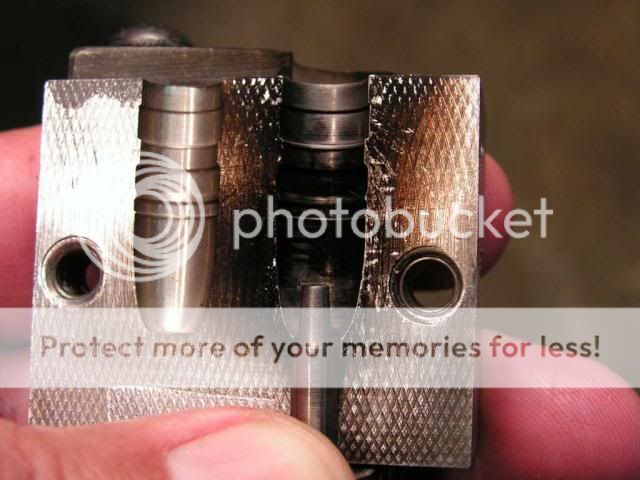Ian,
I'm not trying to be cute or smart, but how can different philosophies support the nose at different points ? Considering that philosophy is the study of ideas about knowledge, truth, the nature and meaning of life, etc.
Maybe my chance to learn something here ?
Ben
Ben, some take the approach of a parallel-nose bullet and fiddle with things until it becomes a slight interference fit in the lands...but not too much interference. The classic "bore rider". Generally, the entire nose is essentially unsupported. That is the "bore/groove" philosophy and it only works at extremely mild velocity and pressure. Lee bullets are perfect examples of this, just fit the bore with the nose and the groove with the driving bands.
Some others notice that rifle throats almost invariably have a taper to them at some point, and may or may not have a parallel freebore. Those same folks may realize that launch pressures often exceed the yeild strength of the alloy, and wish to contain the bullet with minimal deformation to prevent damage that will make the bullet out-of-balance in flight. So they design a bullet that mimics the throat shape very closely, though that method has its own set of challenges as Brad outlined. Obviously, this is not a very effective way to make production moulds because a given design would fit only a few production chambers, and normal erosion alters that original cut as the gun is used.
Then there is the "self-aligning" concept, based on the, yes "philosophy" or more accurately, the hypothesis, that the best way to achieve perfect alignment with the necessary tolerances of fixed ammunition is while the bullet is actually moving out of the case neck. Fixed ammunition needs wiggle room to function in the gun, and that precludes "perfect" static bullet alignment. Not that it stays perfect for long after the primer is struck anyway. So some muse that the nose needs to be convex in order to funnel itself into the throat, and some think the opposite. Of the concave nose philosophers, some design the entire curve to be more steep than any part of the throat that will contact. Others design concave bullet noses which are entirely more narrow than any throat angle so they can wiggle around more in the back than the front. Still others design the nose concave with a less-than-throat-angle front part, and greater-than-throat-angle rear part, sort of a parabola or two or three angle nose.
MY philosophy, as always subject to revision as I learn more, is essentially the latter. I've had the best results, at any velocity, using bullets that have a nose which begins slightly more "acute" than the leade angle, and end slightly more "obtuse". Those aren't the right terms for it, but I'm behind on my coffee intake this morning. There is a whole set of guidelines for making this work, based on alloy type, hardness, and pressure. Generally it works best with a low-antimony, lower-tin alloy that's either air cooled, water-quenched, or oven heat treated to match the pressure used. Below about 16-1800 fps, tin and antimony can be equal and do fine, sometimes better than the low-antimony material
depending on the powder burn rate. Why all the fuss? Because how this design works depends on the bullet going through a metamorphosis at launch: First, the powder needs to ignite and begin burning slowly to minimize the speed the bullet has when it actually engages the leade and bangs around to find center. If the bullet is moving too fast, it will simply crush into the side of the throat and be crooked ever after. So we want it to self-guide and GRADUALLY engage the leade angle, not smack into it all at once. Powder pressure rise is a curve, and with this design, engraving pressure is also a curve. Those two lines will cross at some point, and right before they do, the alloy strength should be exceeded by the powder pressure. What that does (as the back part of the nose starts to be folded back by the leade angle) is force alloy up through the bullet from the back and cause the middle part of the nose (which should be smaller than the throat at that point and only front and rear of the nose touching) to "bump" to a perfect throat match. More perfect than you can get with any static fit. Essentially this method involves breech-seating the bullet with powder. To pull it off, the alloy needs to have the grain structure conducive to "drawing" rather than "squishing", the burn rate and pressure must be within a narrow window, the pressure curve must be the correct shape for the characteristics of the alloy, and the guy pulling the press handle must do his job to set all this up with proper static fit...not too much jump, not too little, just the right neck tension for the system, finding the bullet body size that the system likes, and a few tricks of neck preparation help such as leaving an unsized bit at the base to aid pre-alignment, turning necks to reduce thin spots and aid in concentric bullet release, leaving a little flare on lower-velocity stuff, etc.
The problem I keep seeing over and over is that nose shape either is ignored or mis-understood, particularly with copies. Everyone is guilty of this to one extent or another. Walt had his own ideas of bullet fit, and from what I hear they were mostly spot-on. I see three distinct radii on that 360-262 nose, and off the top of my head can see two common manufacturer's chambers that will use that to maximum advantage, one being the abruptly-throated Marlin .35 Remington chambers. So my whole point here is to get everyone to think this through, think of the applications, alloy that will be used, pressure levels, and do some pound casts and talk about throat shapes before jumping off into a new design. Or if doing a direct clone, make sure the subtleties that make a good design work are accurately duplicated. There's a lot more to successful bullet design than meets the eye.
 Attached Thumbnails
Attached Thumbnails





